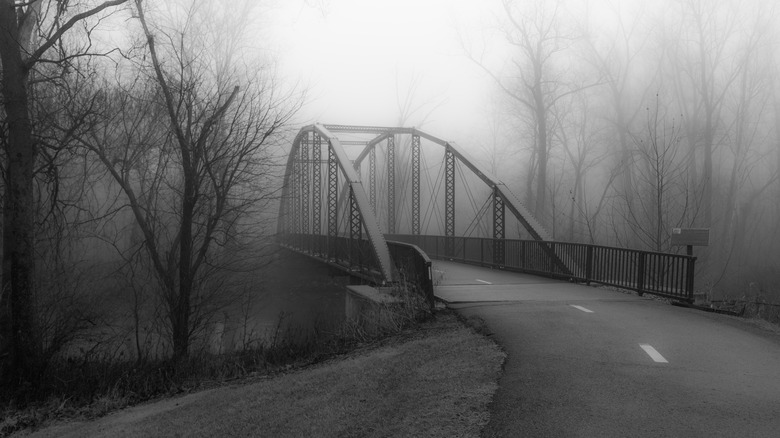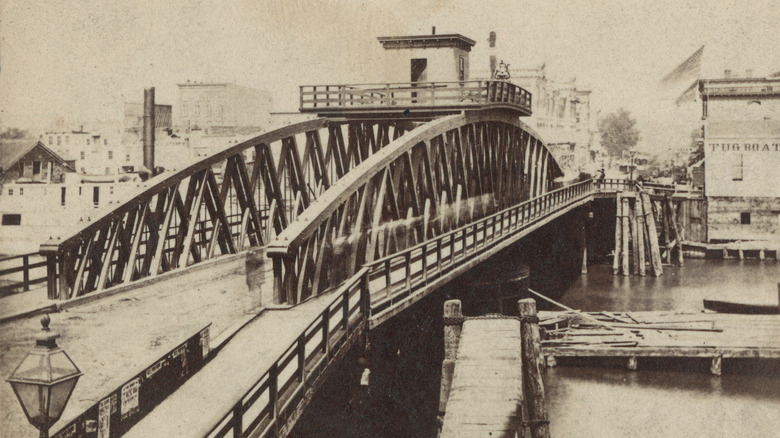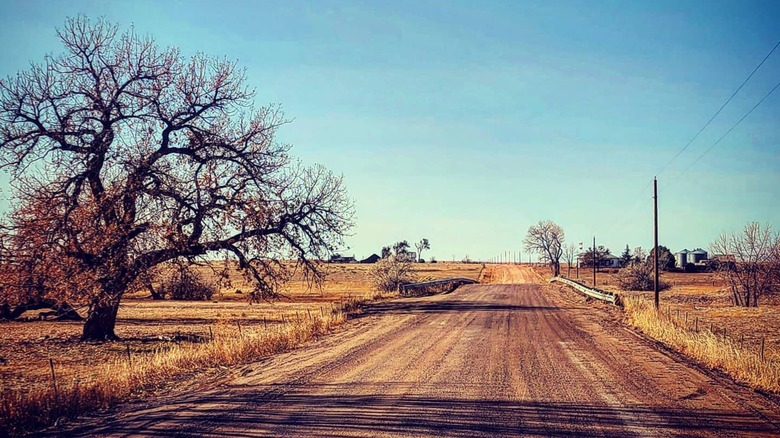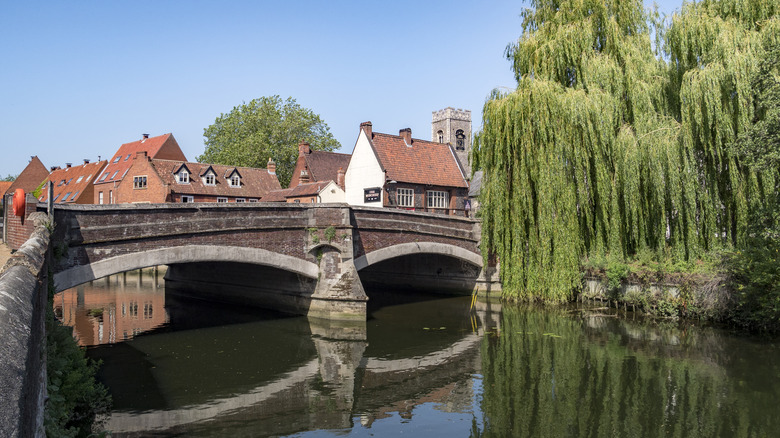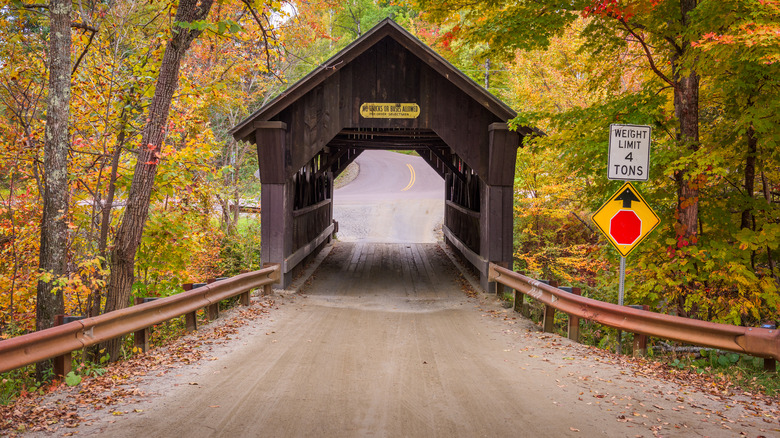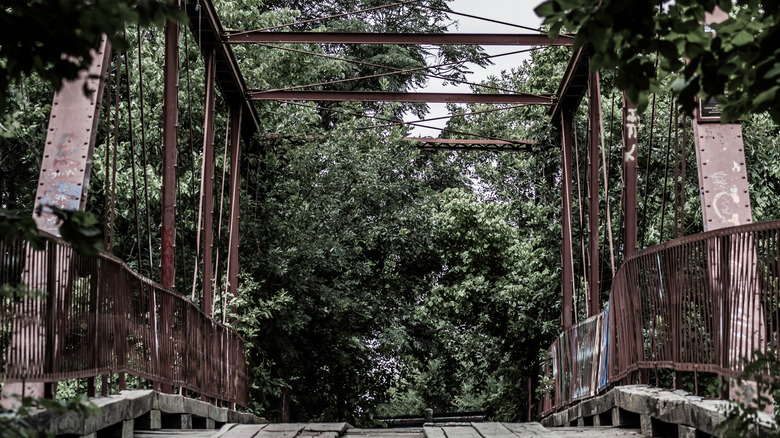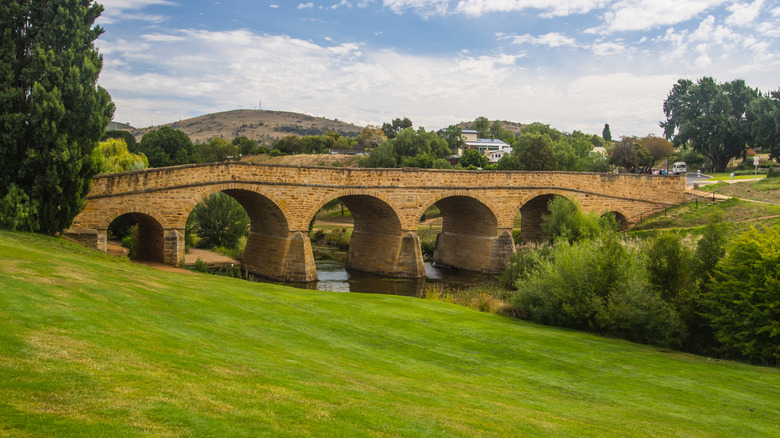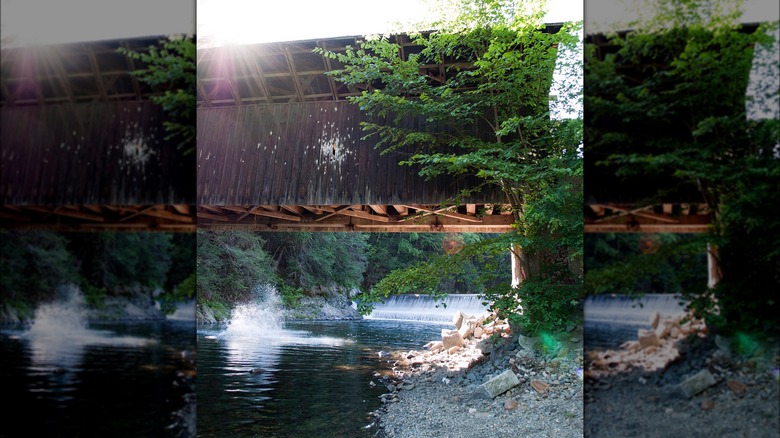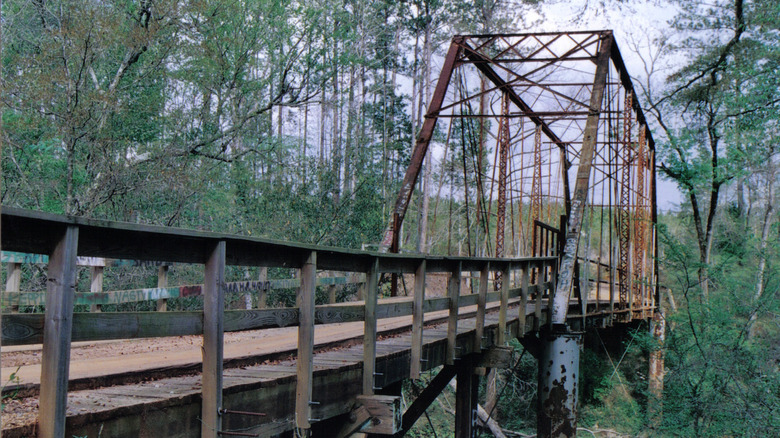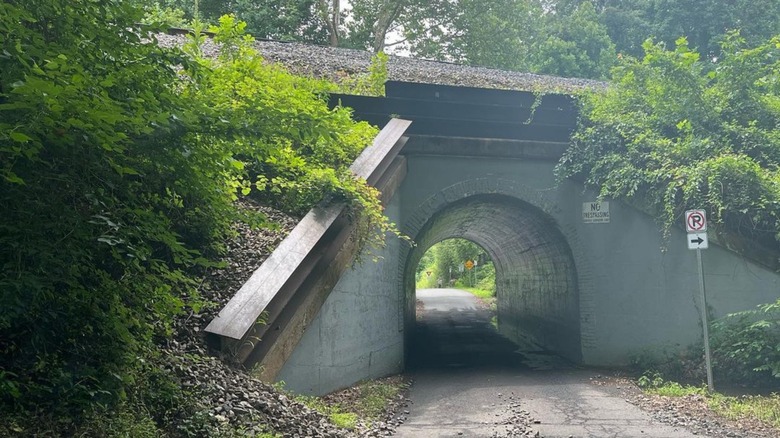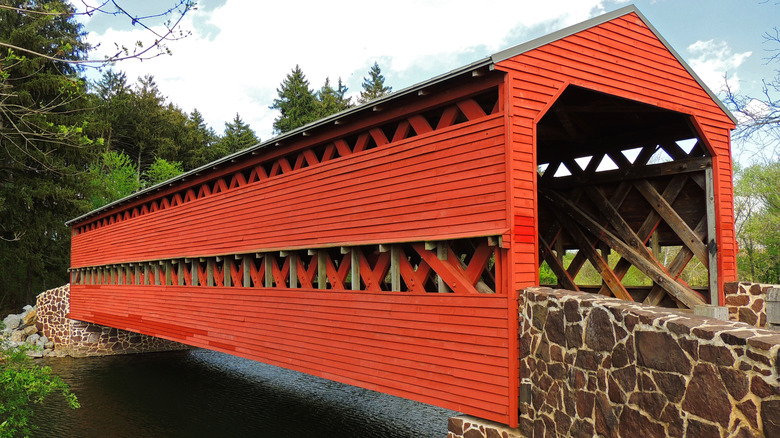The Dark Truth Of The Most Haunted Bridges In The World
Bridges may seem to be pretty innocuous places. Apart from the odd bridge collapse here and there, they have become taken for granted as they allow us to easily cross rivers, creeks, ravines and the like. Unless you're a covered bridge enthusiast or an engineering nerd, chances are that you don't go out of your way to really consider these structures. But perhaps you should. Some bridges are supposedly home to spirits who have spent more time on the span than the few minutes it might take to cross it.
If you've heard of a local haunted bridge legend, chances are good that it's a variant of the crybaby bridge. In this story form, a parent and child often meet a terrible end on the structure. One or both are left to cry out on the bridge long after their deaths and perhaps lightly menace thrill-seekers who visit the bridge after dark by offering up ghostly phrases and manifesting a glowing orb or two.
Beyond that basic form, there remains plenty of room for chilling tales of haunted bridges across the globe. And while some of the tales behind them are hard to verify, other spots are linked to very real horrors still affecting communities to this day.
Clark Street Bridge might be replaying disaster
It happened on the morning of July 24, 1915. Thousands of crew and passengers had boarded the steamer Eastland, which was to set out from the Chicago River to cross Lake Michigan. It was meant to be a nice day out for employees of Western Electric Company and their families. But, before it even left port, the ship became overloaded with over 2,500 people and enough lifeboats for the majority of passengers stored on the upper decks — the weight ultimately a hazard. It began to list dramatically and quickly rolled onto its side. While some passengers escaped, others floundered in the water and were trapped by debris or the ship itself. All told, 844 people died in the disaster, compared to 829 in the 1912 Titanic sinking and 785 in the Lusitania wreck earlier in 1915.
Chicago citizens were traumatized by the disaster, of which an estimated 70% of the dead were under 25 and included 22 whole families. If more modern reports are to be believed, the shock and horror of that day lingers even now. Some claim that if you stand on the nearby Clark Street Bridge, you might catch a glimpse of victims floating in the water. Paranormal investigators who have used underwater microphones on or near the bridge also claim to have picked up voices, some of which they maintain spoke in Czech — the native language of many of the deceased.
Bulgaria's Devil's Bridge has a creepy story
In quite a few places across Europe, so-called devil's bridges are associated with Old Scratch himself. The general shape of the legends has the devil approaching a bridge builder and offering his infernal help in exchange for a terrible price. Many accounts give the bridge builder wits and have him (or his canny wife) tricking Satan into accepting the soul of a barnyard animal. Yet, in other stories, it's all but impossible to get out of a deal with the devil.
Such are the stories associated with Bulgaria's Dyavolski Most, or Devil's Bridge. Spanning the Arda River near Ardino, the current bridge was constructed in the early 16th century but was situated on top of a much older Roman span. With its unique and graceful arches, as well as the dramatic mountain landscape on either side, onlookers don't need to wonder why it was declared a cultural landmark back in 1984.
But while the spot is a prime location for a peaceful picnic, it's also said to be host to some seriously creepy tales. One local legend holds that the builder's wife died in the midst of the bridge's construction and, somehow, her shadow was incorporated into the stone structure. True to the name, the devil's footprint is said to be in one of the stones. Others say that, if you look into the water, you might still see the face of the devil staring back at you.
Colorado's Third Bridge is linked to real massacres
It may look like an unremarkable, graffiti-scrawled bridge on the plains of eastern Colorado, but the Third Bridge near Bennett may also be the spot for chilling otherworldly encounters. Visitors who have made a late-night trek to the spot — which can be an annoyance for area residents wary of thrill-seeking teens — claim to hear all manner of eerie sounds, including noncorporeal drums and phantom voices.
While skeptics may say it's all a bunch of hooey, there are real tragedies linked to the area. Besides a few deadly car crashes that happened nearby, the Third Bridge is about 30 miles from the site of the Hungate family murders. On June 11, 1864, Nathan and Ellen Hungate, along with their young daughters Laura and Florence Hungate, were found dead near the cabin of Isaac P. Van Wormer, their employer.
The murders added to rising tensions between white settlers and local Indigenous people, who were accused of the massacre, though there was no evidence for this. As a result, local citizens rose up against their Native neighbors, which then led to an even larger massacre. On November 29, near Fort Lyon (about 130 miles from Third Bridge) 675 United States soldiers attacked an encampment of Cheyenne and Arapaho, many of whom were women, children, and elders. More than 230 Native people were killed in the surprise attack.
Fye Bridge is haunted by England's witch hunting past
The English city of Norwich has plenty of bridges, but the oldest one still standing may be the creepiest of all. First recorded in the middle of the 12th century, Fye Bridge has been rebuilt over the years but may still be host to the past.
Though unconfirmed in the historical record, many people claim that the area near Fye Bridge was where the city had its ducking stool. People accused of witchcraft (mostly women) would be affixed to the stool and then submerged in the river. If they survived, they were a witch. If they didn't ... well, at least they had been innocent. It was all part of the 17th-century witchcraft panic that swept through England, helped along by a highly religious and paranoid King James I, the 1603 Witchcraft Act that made witchcraft illegal, and opportunistic witch hunter Matthew Hopkins.
Today, that heavy history is believed to still hang around Fye Bridge. One unnamed woman from the era is said to still haunt the bridge. Local legend maintains that she asks passers-by to help her pick up a bunch of sticks, which were said to have been part of the pyre used to burn her. Anyone who helps her is believed to die by fire in the coming year. More lucky witnesses at the nearby Lollard Pub have reported hearing unearthly screams from near the bridge.
Emily's Bridge claims one jilted woman turned monstrous
If you just like the picturesque look of a covered bridge, there's already a lot to enjoy about Emily's Bridge. Built in 1844, this single-lane bridge in Stowe, Vermont, is a lovely example of historic New England.
If you want an edge to your next leaf-peeping adventure, Emily's Bridge is said to bring the creepiness, too. As the story goes, Emily was a lovelorn 19th-century woman who went to the bridge to meet with her lover. Realizing she'd been stood up, Emily died by suicide on the bridge. Now, the perpetually disappointed young woman is believed to menace passers-by, scratching cars and even an unlucky pedestrian or two. Other visitors have reported odd lights, formless voices, and even the ghostly figure of a woman who might just be the bridge's namesake.
The legend of Emily's Bridge has changed a fair amount over the years. Depending on when the story was told and who's telling it, Emily might meet her end via her own hand or by accident, perhaps on foot, while driving a team of horses, or, beginning in the 1920s, in a car. Yet, there are no records of anyone dying at the bridge, much less a broken-hearted woman named Emily. Stories of the haunting appear to have begun around the 1960s or later, perhaps even as a legend specifically crafted to scare kids.
The Goatman's Bridge is said to be home to a demon
When it comes to tales of eerie, possibly haunted bridges, the Goatman's Bridge is all but inescapable. Spanning Hickory Creek, it's located near Corinth, Texas. The iron bridge was constructed in 1884, well after the town had shuttered by the late 1850s, though it came to be known as the Old Alton Bridge anyway. Pedestrians can still cross it, but they might think twice about doing so once they hear the local legends.
Most retellings say that there was once a Black goat farmer nearby named Oscar Washburn. Dubbed the "Goatman," he became so prosperous that local KKK members attempted to lynch him on the bridge in 1938 — but Washburn disappeared in the process. Thereafter, the bridge has been haunted by stories of apparitions, missing people, strange noises, and a possibly demonic figure with a goat's head and stomach-turning odor.
Others say the victim was a different goat herder named Jack Kendall, who was beheaded by vigilantes. His headless body supposedly arose, plucked a goat's head off as a replacement, and began menacing the bridge. However, there are no records of an Oscar Washburn or Jack Kendall in the area. Neither are there any known violent events at the bridge, in 1938 or otherwise. Of course, try telling that to anyone who shows up to the Goatman's Bridge, and you'll likely earn yourself a round of boos.
I-4's Dead Zone is haunted by tragedy
Florida's Interstate 4 highway, often referred to as I-4, holds the dubious honor of being one of the most deadly highways in the U.S. One particular portion of I-4 between Orlando and Daytona Beach has earned the ominous nickname of the Dead Zone. The section of the highway, which includes the St. Johns River Bridge that spans part of Lake Monroe, is said to be plagued by poor cell phone reception, odd static, eerie lights, and ghosts.
As museum coordinator Bennett Lloyd told local outlet FOX13 in 2019, a family of four German immigrants was buried nearby after a brutal yellow fever epidemic took their lives in 1887. Their graves were disturbed in the 20th century but never moved — not even when I-4 came to town. The burial site was supposedly left in place near the overpass and bridge.
Disturbed by the rumble of cars and trucks nearby, the immigrant graves have since been blamed for the many accidents nearby, not to mention apparitions of a white horse and a hurricane that hit the spot in 1960. Of course, the traffic deaths on the bridge may also be linked to the fact that the original bridge (replaced in 2004) had no shoulder, which forced broken-down vehicles to block traffic and possibly caused more accidents.
Richmond Bridge speaks to Australia's brutal convict past
As the only stone arch bridge currently standing in Australia, Tasmania's Richmond Bridge already has some decent historic cred. But then there's the fact that it was constructed by convict laborers, some of the many people transported from Britain to what was then a British penal colony in the 19th century. Prisoners must have put in backbreaking amounts of labor to build the 135-foot long, 25-foot wide bridge, which opened in early 1825 and is still in use today.
The convict history of Australia is an oftentimes ugly story. People transported halfway across the globe as convicts could have been guilty of heinous crimes or relatively minor ones, but all were subject to hard labor, painful physical punishment, and inhumane living conditions that could include toiling under violent overseers.
One of those overseers, George Grover, is said to still hang around Richmond Bridge. Once a convict himself, Grover earned a position as a flagellator who earned an especially bad reputation for beating convict workers constructing the span. Modern visitors to the bridge have claimed to spot him lingering on the western part of the structure, while others claim that Grover's dog — hopefully a much nicer specter — will walk alongside you if you cross the bridge after dark.
The Eunice Williams Covered Bridge has a bloody history
The Greenfield, Massachusetts, structure now called the Eunice Williams Covered Bridge is actually a 1972 recreation of an 1870s bridge. But local legend holds that the very spot where it crosses the Green River is where a woman named Eunice Williams was brutally murdered centuries ago.
Eunice was one of the victims of an attack on what was then the rural outpost of Deerfield, later referred to as the Deerfield Massacre. On February 29, 1704, a group of about 50 French and 200 Indigenous combatants struck the English settlement. Forty-eight residents were killed, and 112 were taken prisoner and marched north to Canada, a journey of some 300 miles. One of the first households attacked was that of Rev. John Williams and his wife, Eunice Mather Williams. After three of her children were killed in the attack, Eunice and her remaining family were made to march. By the time the captives made it to the Green River, she had grown so weak that she couldn't keep up and was killed on the spot.
With such a brutal end, it's no wonder that Eunice is said to linger near the site of her death. Some have reported seeing a mysterious woman searching for her family, occasionally wandering just beneath the bridge. Others allege that, if you roll up in a car on a night with no moonlight and honk, she may appear on the bridge itself.
[Featured image by davidpinter via Wikimedia Commons | Cropped and scaled | CC BY 3.0]
Some say Stuckey's Bridge is haunted by a killer
Not far south of Meridian, Mississippi, is an old bridge crossing the Chunky River that opened in 1851. The aging structure was closed to vehicles in 2001, though ghost hunters still often make the trek to the old iron bridge today. As local legend goes, a man named Stuckey is said to have owned a nearby inn. Stuckey was perhaps a member of the outlaw Dalton Gang that menaced the Old West in the 1890s. Even if he wasn't, Stuckey was said to be a bad sort. He allegedly lured travelers into his inn and then murdered them before stealing their wares. After he was caught, Stuckey was hanged from the bridge.
Beginning in the 1930s, some have claimed to see the figure of Stuckey on the bridge, gesturing with his lantern to travelers as he did while alive. On the bridge, others say they have heard a heavy splash, supposedly the same sound that Stuckey's remains made when they were cut down and tossed into the river below. And, of course, it wouldn't be a very good haunted bridge if spooked teens didn't hear the ghostly screams of Stuckey's victims.
While the legend of Stuckey's Bridge is all but impossible to confirm, the bridge itself is a very real historic landmark. It gained status as a Mississippi Landmark in 1984 and ascended to the National Register of Historic Places in 1988.
[Featured image by Dudemanfellabra via Wikimedia Commons | Cropped and scaled | CC BY-SA 3.0]
The Bunny Man bridge went from real incident to local legend
Wild as the Bunny Man legend may sound today, it has its roots in a real incident. Fairfax County Library historian Brian A. Conley found an October 22, 1970, issue of The Washington Post in which a Virginia couple claimed that they had been sitting in their car together shortly after midnight. A man — reportedly wearing bunny ears — appeared and yelled that they were on private property before throwing a hatchet through the car window (no one was injured). Another report two weeks later said that a person wearing similar garb hacked away at a newly constructed home nearby. A security guard said that the bunny man loudly complained about trespassing and threatened the guard with an ax. The costumed man was never identified.
However, the 5400 block of Guinea Road, where the first couple reported their encounter, is quite a ways from the Colchester Overpass where the rabbit-like figure is said to linger. But why let logic get in the way of a good urban legend? The overpass has since been dubbed the Bunny Man Bridge. One story says that the Bunny Man was a mentally ill murderous convict who escaped when his prisoner transport bus crashed. He was supposedly killed by a train, but you might hear that anyone who visits the bridge at midnight on Halloween still runs the risk of being brutally murdered by the specter.
Sachs Covered Bridge has a grim Civil War connection
Given the bloody toll of the American Civil War — many sources estimate 620,000 dead — it would be shocking if there weren't tales of lingering spirits on battlefields, in historic buildings, and even on a bridge.
That would be Sachs Covered Bridge, located near the Gettysburg battlefield in southern Pennsylvania. With over 50,000 casualties over three days, the July 1863 engagement was the most deadly of the entire war. The bridge itself was built around 1854. Just before the 1863 battle, three spies for the Confederacy were reportedly hanged on the bridge. Some accounts state the trio were actually Confederate deserters sporting stolen Union duds, but no matter their crime, things are said to have ended very abruptly for them at the covered bridge when their plot was revealed.
Now, visitors to the bridge have claimed to see three heads manifest out of the darkness, while others say they have spotted full-body apparitions. Other paranormal experiences have included smelling cigar smoke in the air, hearing the sounds of fighting, and feeling a phantom hand on the shoulder. Some have even claimed to see a large group of phantom soldiers marching across the bridge.
